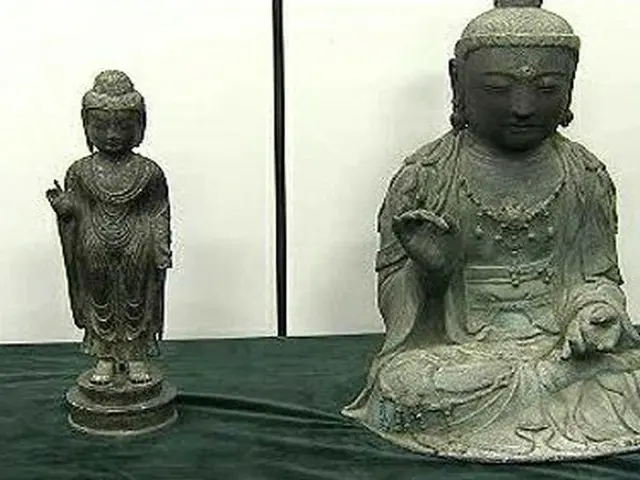The head priest of the Busok Temple in South Korea, which has been claiming the statue as its original owner, stated in an interview with the news agency that he would "cooperate" with the return of the statue to Kannonji Temple after May of this year.
The Supreme Court ruled in October 2023 that the temple should own the Kannonji temple property. Since then, there have been no moves toward returning the statue, but in June last year, Ukisekiji held a 100-day memorial service to pray for the statue's safety before its return.
In a letter to Kannonji Temple, they conveyed their intention to not oppose the return of the remains to Japan, provided that a memorial service for a few days is held. According to Kyodo News, the head priest of Buseoksa Temple, Won Woo, said,
The earliest the temple can be returned is between mid-February and late May. Kyodo said, "It is said that they are coordinating with Kannonji through political sources to return the temple in early May, but there is a possibility that the process may be delayed."
The Kannon Bodhisattva Seated Statue, a designated tangible cultural property of Nagasaki Prefecture, which was in the possession of Kannonji Temple, was stolen by a Korean thief group in October 2012 and brought to Korea.
The temple was arrested by the Korean police and the statue was confiscated, but the temple claims that the statue was "looted by Japanese pirates in the Middle Ages." In 2016, the temple filed a lawsuit against the Korean government to stop the statue from being returned to Japan.
In the first instance, the South Korean court ruled that the contents of the records found inside the statue, as well as records from the History of Goryeo that state that Japanese pirates had invaded the Seosan area five times since 1330, were unfounded.
The court concluded that the statue had been taken from the temple through looting or other means. In 2017, the court ruled that the statue was "fully presumed to be the property of the temple," and ordered the statue to be handed over to the temple.
The Japanese side rebelled against this ruling, which became one of the factors that worsened Japan-Korea relations. After the first trial ruling, the Korean government appealed the ruling, claiming that the relationship between the statue and the Buseoksa Temple had not been sufficiently proven, and moved it to Daejeon, central Korea.
The case was tried again at the Daejeon High Court in the city. In February 2023, the Daejeon High Court overturned the first-instance ruling and handed down a ruling recognizing the ownership of Kannonji Temple.
"It is possible to confirm that Fusekiji Temple produced Buddhist statues in 1945, and there is also evidence that they were plundered and illegally taken away by Japanese pirates," he said. "However, it is unclear whether Fusekiji Temple at that time was a religious institution belonging to the same religion as the current Fusekiji Temple.
"It cannot be proven that the Kannonji Temple is an organization," he pointed out. The "acquisition prescription" under the civil laws of Japan and Korea, which states that ownership is recognized when the Kannonji Temple holds the property peacefully and openly for a certain period of time, has been established, and the current ownership is that of the Kannonji Temple.
The Supreme Court ruled that the statue belonged to the temple. Buseok Temple appealed the ruling to the Supreme Court. In October 2023, the Supreme Court dismissed the lawsuit by Buseok Temple and ruled that the ownership of the statue belonged to Kannon Temple.
The Supreme Court recognized that the current Buseoksa Temple is the same as the "Seju Buseoksa Temple" that created the Buddha statue in the 14th century, but upheld the ruling of the second instance that the "prescription of acquisition" under the Civil Code had been established.
The South Korean government needs to consider this issue in light of international norms. This issue, which was one of the factors that worsened Japan-South Korea relations along with the former forced labor lawsuit issue, has been on the rise since the Supreme Court ruling.
It was expected that the procedure for returning the statue would proceed, but for some time after that, there was no noticeable movement toward returning it. The statue is kept in a facility of the Korean government, but the temple has not removed the statue from the facility.
The decision was made to temporarily move the statue to Ishidera, hold a memorial service for 100 days to pray for the statue's peace, and then return it to the Kannonji temple. In June of last year, the government sent a letter to the Kannonji temple outlining these plans.
The former head priest of Kannonji Temple, Setsuryu Tanaka, initially expressed displeasure, saying, "(Korea) is talking as if they are going to hand it over, but that's no joke," and added, "(The statue) has belonged to Kannonji Temple since the beginning, and it still belongs to Kannonji Temple.
We want to continue raising our voices until that day," he said, but ultimately Kannonji indicated that he would accept the move on the condition that it be "guaranteed returned."
According to Kyodo News, the head priest of Ukishiji Temple, Enushi, responded to an interview with the news agency on the 26th of last month and said about the Buddha statue,
In South Korea, President Yoon Seok-yeol, who had been working to improve relations with Japan, was impeached, and political turmoil ensues.
The temple is still in the process of being returned, but in an interview, the head priest, Enushi, said he believed it should be moved forward "regardless of the political situation." Religious groups and other organizations involved have also submitted written guarantees to the Kannonji temple for the temple's return.
If the statue is returned this year, it will finally be returning to Kannonji Temple after 13 years.
2025/01/06 11:57 KST
Copyrights(C)wowkorea.jp 5

